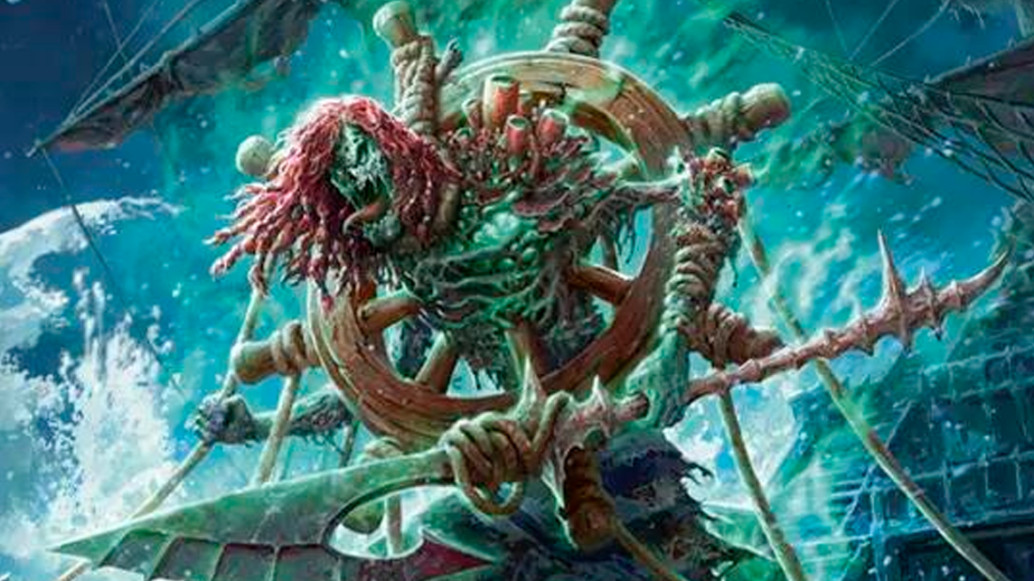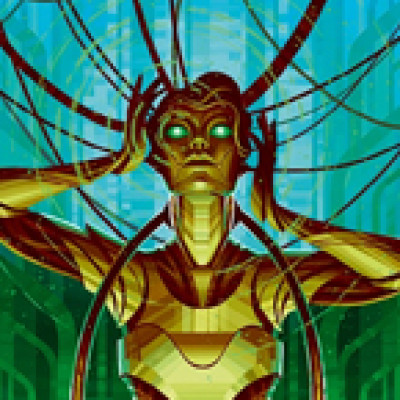Welcome back aboard the Dreadnaught matey! We’ve been sailing these High Seas for many a fortnight and have amassed treasures beyond imagining. Our crew has struck terror into many a foe and -
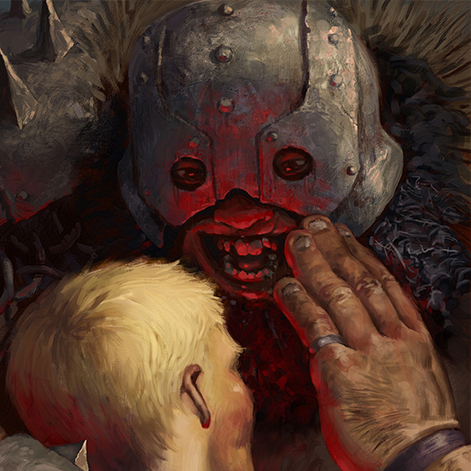
THAT’S ENOUGH OF THE SEA SHANTY TALK!!!
BECAUSE I DON’T KNOW IF YOU FANS OUT THERE HAVE HEARD, BUT THE EVENT OF THE CENTURY HAS LANDED!!!
SO GRAB YOUR FRIENDS, YOUR PARENTS, AND EVEN YOUR CAT, AND GET HYPED FOR THE SUPER SLAAAAAAAAAM!!!!!
Yes! Super Slam has been out for a few weeks now and I am beyond excited! Despite the set itself being focused on Brute and Guardian cards, LSS gave us an enormous amount of expansion slot cards this time around. A whole thirty-one in total, with a very specific one being of great interest to me: Gallow, End of the Line.
Welcome Aboard the New Hire
I must say, I was surprised to see support for Gravy in the game’s newest set - though I suppose this fine fellow being printed gives a greater significance to LSS’s ban of the red and yellow copies of Golden Tipple. Allowing Gravy full access to up to nine copies of Tipple, in addition to a new ally that can deal with the deck’s greatest weakness? I don’t think that would have gone over well for the format at all.
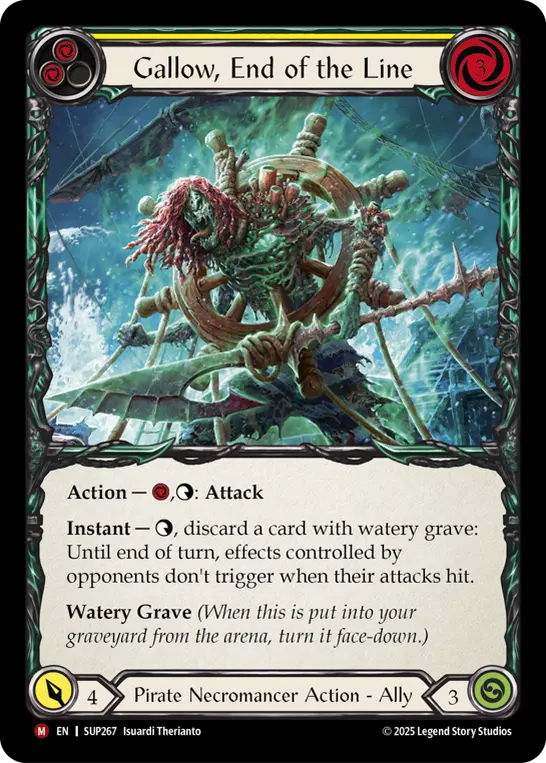
Gravy had to be powered down not only because of his meta dominance at the time, but also because he was getting access to this incredible new tool. For me, this means that I will be able to play Gravy for a much longer period of time! Frankly, an abundance of good news. Or rather, it would be good news if I didn’t think Gallow being printed will be a cause for Gravy’s power level in the format to rise to new heights; Gallow is extremely powerful for Gravy to have access to, and from discussions I have seen online I think people are underestimating just how powerful he is.
I think this mis-evaluation is due to Gallow’s numbers being a lot more difficult to calculate than that of other allies in the deck. For example, when you look at Riggermortis, the numbers are quite easy. He costs one resource to play, one resource to attack, has 6 power, and 1 health. You add all of this together and you get an ally that has their value floor be seven (power + health) for two resources. These numbers are extremely good, easy to parse, and that's one of the main reasons why good ol’ Morty always has the full three copies in every single Gravy deck.
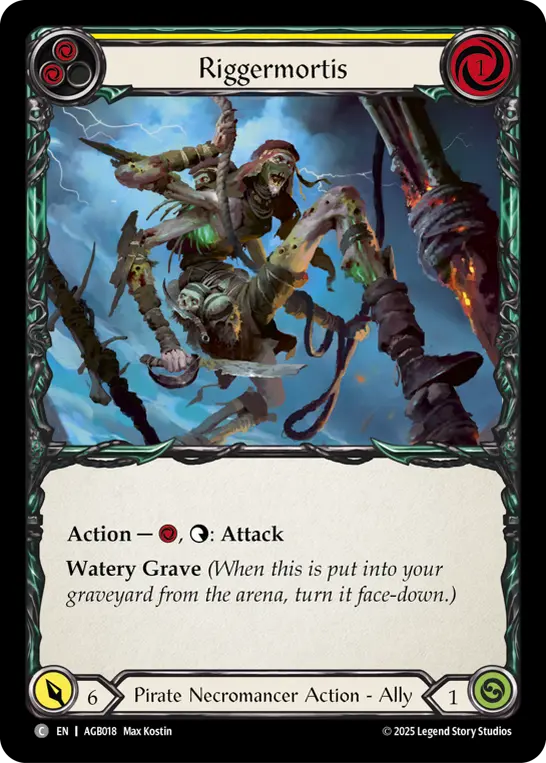
Gallow isn’t so straightforward. If you take a look at the numbers Gallow presents through the same lens as Morty, you really aren’t painting the best picture. He costs three resources to play, one resource to attack, has 4 power, and 3 health. Like Morty, you’re getting an ally that gives you seven value, but is costing twice as many resources at four instead of two.
It's at this point where I have seen a lot of discussions on Gallow essentially end. You do the math, see that your value proposition at the floor is the same as what Morty offers but for twice as much, and determine this juice isn’t worth the squeeze. I have to say though, I think comparing Gallow to Morty is a bit unfair as he’s basically one of the best three allies Gravy has access to in the entire game. It’s perfectly fine if Gallow isn’t meeting the standards of one of the best things we can do. Which poses the question: Is there a better ally to compare Gallow to then?
There is, and his name is Swabbie.

Swabbie is a contentious ally in Gravy Bones decks. I have hated having to run this ally in my inventory, but he has been an essential crew mate. Much like Riggermortis, Swabbie’s stats are overwhelmingly easy to evaluate: three to play, two to attack, 7 power, and 3 health giving us a total value of ten for five resources. The main reason Swabbie is such an annoying ally to have to play is because of the five resource cost to get your floor value. Not only do you have to first play a blue card to turn on playing him from your graveyard, but then you need almost two more blue cards in order to get that value. This has caused the most useful Swabbie turns to be ones that involve a blue copy of Saltwater Swell, since the resources you have left over from Swell pitching a blue card off the top of your deck (assuming you pitched a blue to play it) is that lovely number five. Outside of this specific scenario though, Swabbie is incredibly difficult to set up to start applying pressure on to your opponent.
But there's a more significant reason as to why this 5-cost on Swabbie is extremely detrimental. The main loop in Gravy decks stem around playing a blue card, getting an ally into your graveyard, and playing and attacking with said ally. Getting an ally into your graveyard gives you access to a resource off of Dead Threads. This is why Chum's costing four resources to play is not an issue. Even if you have to play a blue card and pitch a blue card, as long as you have had an ally - or Chum himself - go to the graveyard that turn, Dead Threads will give you that fourth resource you need without issue. Four resources is actually the resource stress point for this deck, which determines whether a card requires one or more pitched cards in order to play.
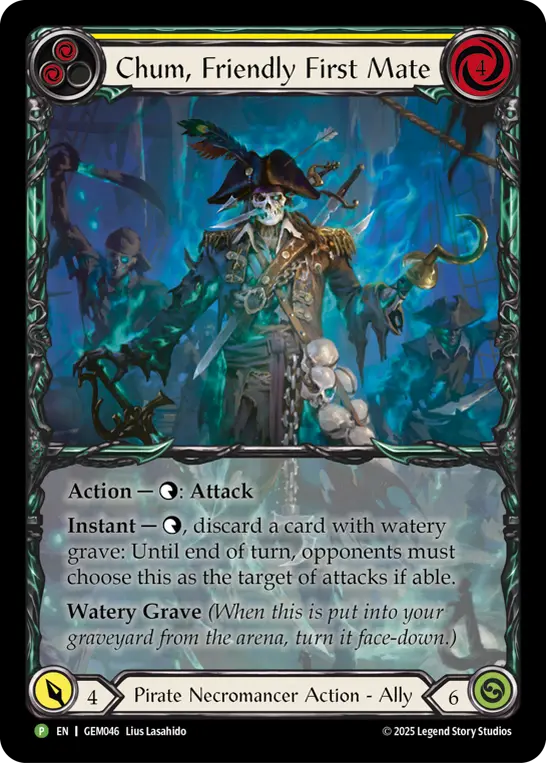
Wait a minute, what was the full cost on Gallow again for his floor? Oh yes, it was four, wasn’t it?
This is why I think Swabbie is a much better ally to compare Gallow to. Instead of running an ally that has a value cost that is over our stress point, we can instead replace it with one that is at that stress point. Not only does this mean we now are running a card that is much easier for us to play in a lot more situations, but the fact that Gallow has other text we haven’t even talked about yet means we are also running an ally that has utility that is more than just “I have a big number”.
With all this said, however, seven for four is still not a great comparison against ten for five. You are, in fact, losing a lot for just that one resource. And this is where I have to be honest and say that I’ve been technically lying to all of you. Because Gallow’s value is in fact, much more than seven.
The Captain Says "No"
The absolute floor on Gallow's value proposition is indeed seven. If you play him, attack with him, and then he immediately dies on your opponent’s next turn, you will have only gotten seven value out of the ally. Yet Gallow can do more than just attack. Let’s take a look on that text in his second ability again:
Instant - tap, Discard a card with watery grave: Until end of turn, effects controlled by opponents don’t trigger when their attacks hit.
This. Is. MASSIVE!
One of the biggest weaknesses Gravy decks have had to deal with is that, when a card triggers “on hit” (and not specifically when it hits a hero), the allies become free triggers. That means Heralds from Prism, Mask of Momentum from Ninjas, Dori's Dawnblade!



Suddenly we have access to a card that allows us to just completely turn off each and every one of these effects for a turn, and net us value in the process due to what our opponent is losing on their own turn.
Of course this isn’t going to be something that is useful into every hero, but I really think that it is what pushes Gallow’s value proposition into areas that are extremely good. To give an example where the math is easy to evaluate, let’s consider you are playing against Dash I/O. Through activating Gallow, you prevent a red Boom Grenade from exploding and dealing an extra four damage to you that turn. This four extra life you now have can be added to Gallow’s previously-provided value of seven, which puts him up to giving you eleven value for four resources. Those numbers are better than what is offered by Chum!
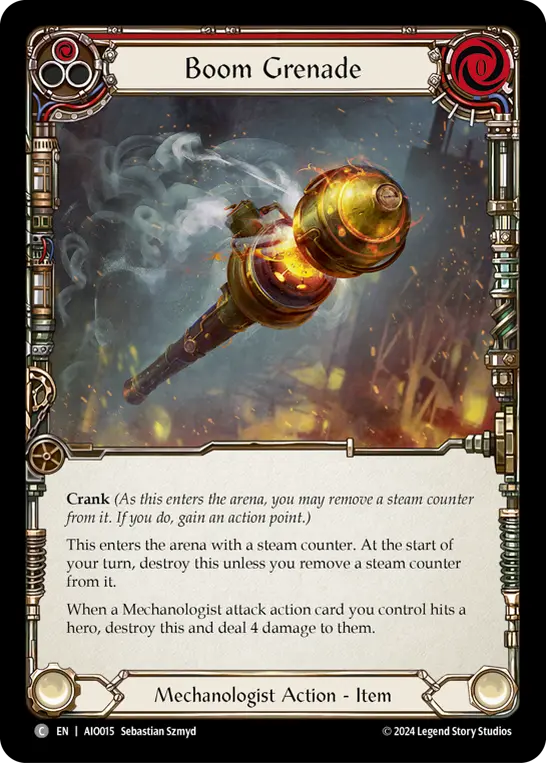
Obviously the math isn’t always so cut and dry as this. How much value is lost when your Cindra opponent can’t draw a card off of Mask of Momentum? If Prism doesn’t send a Herald to soul from the on-hit and thus can’t tutor for a figment, how do you represent that numerically? This is where I think properly evaluating Gallow gets muddy and I don’t have a definitive answer for everything. Rather, I feel the best way to approach this is to instead list the matches where Gallow is effective, and I will leave the value interpretation up to you.

Why not start with the most widely played Generic card in the entire game? Gallow will prevent our good friend Command and Conquer from destroying what is in your arsenal, so even if you can’t fully cover the six damage it is throwing at you, you don’t have to worry about losing the card you’ve buried for later. This can actually be pretty important if you’re playing a matchup where you have one of your copies of Blood in the Water waiting in your arsenal, as you won’t lose that defensive card for nothing. I also feel I should point out that if Guardians return to the meta, Gallow also stops the added effect of any Pummels that might be accompanying our popular arsenal-destroyer.
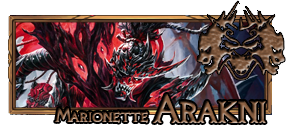
From the on-hits of every dagger the class has access to, to the pesky on-hits they use to try and disrupt your turns, Gallow puts a stop to all of Assassin's tricks. Of particular note: into Arakni, Marionette and Arakni, 5L!p3d 7hRu 7h3 cR4X, if your hero has been Marked you still lose that condition once you have taken damage from an attack, even if you have used Gallow to disable on-hit effects for the turn. This is because, as per rule 9.3.3 in the Comprehensive Rules, “When a marked hero is hit by a source controlled by an opponent, the marked condition of that hero is removed as part of the hit event. The removal of the marked condition is not a game state-process or a triggered effect.”
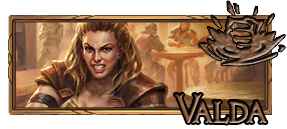
Oh boy do Guardians have a lot of on-hit effects. Crush effects are turned off, as they are on hits triggered from dealing a specific amount of damage. Most of their Tower cards gain on-hit effects that Gallow can just deny. As previously stated when talking about Command and Conquer, Pummel is nothing more than a damage boost in the face of Gallow’s ability. Some people might want to favor Swabbie into Guardians out of fear of being fatigued and wanting to present bigger numbers. However, in my experience fatigue decks excel at that specific strategy when they have the chance to offer the occasional disruptive attack that causes you to waste unnecessary resources. All of which Gallow can protect you from.
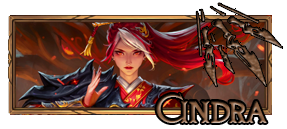
Gallow isn’t terrible into Ninjas, but he is more of a sidegrade for these match ups than an actual upgrade. Into Katsu specifically, being able to turn off his hero’s text box is actually ridiculous, and Gallow can just single-handedly swing the direction of those match ups. Into other Ninjas though, Gallow is mainly just going to be your way to prevent Mask of Momentum from triggering. In these specific instances, Gallow performs marginally better than our previous “anti-Ninja” ally Anka, Drag Under. The issue Anka always had to deal with was that unless the Ninja player had an empty hand (which they usually didn’t) Anka’s effect just meant after triggering Mask they got to choose between two cards and keep whichever of them was the best one for the current situation. Certainly better than if they just got to draw without any downsides, but it still never amounted to much of a positive benefit for you because you were having to tap down Anka, and thus not attacking with them for five on your turn, in addition to discarding an ally which could cost you your Dead Threads use on your own turn. All together, that means activating Anka cost you 6 value in resources, and usually never paid you back nearly that much. With Gallow however, you get to blunt any, and all on hit effects for the turn, not just Mask. So the ceiling on what Gallow’s value can provide you when you activate him is definitely much higher than it ever was for Anka.
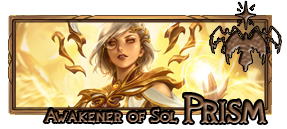
I want to say up front that I don’t think Prism was ever actually a bad match up for Gravy. Sure, all of her Heralds got to trigger for free, but that simply meant the bulk of her damage was never going at your face, giving Gravy a substantially larger health pool. When you can also swing back just as hard at her, only you are directing everything at the face, I never found it to be a match up I struggled with. Gallow I think moves the needle even further into Gravy’s favor. What happens when Gallow is active on one of Prism’s turns?
For starters, any Heralds hitting won’t go to soul, and Herald of Protection and Herald of Erudition won’t make a Spectal Shield or draw cards. Because a Herald has not gone to soul, Prism will not be able to tutor for one of her Figments and put it into play. Nor will any Figment she might have in play be able to be flipped for free due to Empyrean Rapture.
Gallow is so disruptive to what Prism can do for a turn, in the test games I have played against her so far a single Gallow activation has put me so far ahead it has been an absolute struggle for my opponents to ever catch up.
And while I am not ever expecting a Prism player to just walk their Herald of Erudition straight into an awaiting Gallow, it is going to be so hard not to grin like a super villain if it ever does happen.
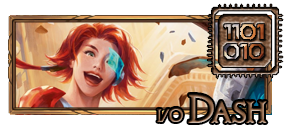
I already gave a quick example of where Gallow is beneficial into DIO, preventing Boom Grenades from triggering. That isn’t all he is good for though. Because you don’t have to activate Gallow right away (unless they immediately try to kill him of course), this means you can wait until just before you would have taken the attack damage to activate the effect. This could also prevent an opponent from cranking their Boom Grenade, which will still net you 2 value in those instances as that crank would have been an extra attack with Symbiosis Shot. In addition to Boom Grenade, DIO does have a few other on hit effects in Heist and Expedite, which both also don’t get to do anything under Gallow’s ability.

I am going to talk about each of the Warrior heroes separately because they are all quite different from each other in how Gallow affects their gameplan. Gallow is huge into Dorinthea for two big reasons: her hero power and Dawnblade. With regards to Dorinthea’s hero power, Gallow turns that off completely, meaning when activating Gallow your opponent only gets to attack with their weapon once for the turn. They’ll likely be attacking Gallow, but because he only has 3 health, either they will be wasting a bunch of pump effects, or they’ll be giving themselves a rather substantial intellect penalty.
For Dawnblade, Gallow prevents the weapon from gaining a counter the second time it has hit. So even if your opponent is using Twinning Blade as a way to get around their hero power being turned off, Dawnblade will not get an extra counter from connecting twice.
(It is important to note, however, that Gallow won’t make it so Dawnblade loses counters; the second ability on Dawnblade only checks that the weapon has hit, and is not a triggered effect from the weapon hitting. So unfortunately Gallow doesn’t make all those counters go down to 0.)
One other notable effect that Gallow shuts down in Dorinthea is Warrior’s Valor, enabling us to prevent the weapon from having go again - yet another way Gallow can completely shut down one of Dorinthea’s turns.
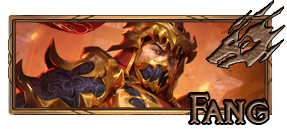
Fang, much like Dorinthea, has the most important thing being shut down by Gallow: his hero power. Creating a Fealty token when we’re Marked and get hit is a triggered effect that Gallow will deny. As I noted when talking about Assassins, in addition to Fang not creating his Fealty token, we will still lose the Marked condition. In addition to all of this, Fang will be unable to reapply Marked to us off of cards like Scar Tissue or Searing Gaze in the same turn, since those are also on-hit triggers. How Gallow effects this particular matchup could severely hamper Fang’s Fealty generation and make things a little bit more even.
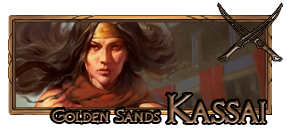
There seems to be a pattern here with Warrior heroes and Gallow in some manner blanking out a part of their text box. Kassai, unlike Fang and Dorinthea though, isn't hampered nearly as much by that effect. Yes, Gallow can turn off her ability to make Gold, though your opponent can just choose to not activate her while you have Gallow on the board. So while it is important, it isn’t as important as Gallow’s interaction with the other Warrior heroes is.
Where Gallow helps into Kassai is turning off all of her cards on-hit effects. Outland Skirmish and Spoils of War lose their ability to generate Copper, and the new Blood Follows Blade doesn’t create a Cintari Sellsword. While there aren’t a lot of effects to turn off from Kassai, each one you are stopping is very important to her gameplan.
Same Ship, New Crew
As you can see, Gallow offers something different into each of the matchups he has potential against. For some heroes, his on-hit negation is backbreaking, and can cause entire turns to be utterly wasted. Into others, he simply helps make the deck run a little more smoothly, and can save you with some crucial interactions. What more could you ask for from a tech card for your inventory?
Over the past couple weeks it's been interesting to watch the Super Slam metagame develop. Going off of the results from our first week of Pro Quest: Yokohama events, Gravy Bones is still topping the charts as one of the format’s best heroes, but Cindra, Verdance, and Florian are all following closely behind - and indeed, that's what we saw with week 2. With the current state of the meta being what it is, I don’t know if Gallow will warrant more than a single slot in some people’s sideboards, but he is an important crew mate to keep in mind as we move into the future.
Gravy Bones gets to sit comfortably right now having a 0.5 multiplier on all of his gained Living Legend points, but the same is not true for some heroes like Florian, Verdance, or Kayo. Any of these heroes ascending to Living Legend status could massively shake up the metagame, allowing for new players to move in to take their place. If any of those new players are decks like Dorinthea that rely heavily on dealing on-hit effects, Gallow will surely have a much better place in any Gravy lists going forward.
Good luck to everyone out there competing in Pro Quest events over the next few weeks! May the waves be calm, and your coffers overflowing with Gold!

